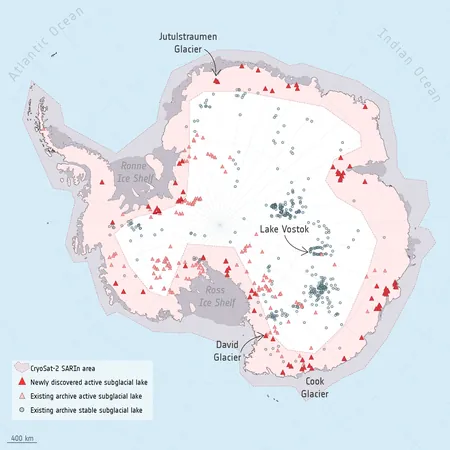
85 Hidden Subglacial Lakes Discovered Beneath Antarctica!
2025-09-20
Author: Ming
Unveiling Antarctica's Secrets: 85 New Subglacial Lakes Found!
Beneath the colossal ice mass of Antarctica lies a hidden world of subglacial lakes that are crucial for understanding the continent's icy dynamics and their effects on global sea levels. Recent groundbreaking research has revealed the existence of 85 previously unknown lakes, significantly increasing the tally to 231 active subglacial lakes!
Utilizing a decade's worth of data from the European Space Agency's CryoSat satellite, researchers made this incredible discovery deep beneath the South Pole, where conditions are incredibly harsh.
The Importance of Subglacial Lakes
These subglacial lakes aren't just fascinating—they play a critical role in how glaciers move and remain stable. Active lakes fill and drain in cycles, offering scientists a unique glimpse into the processes occurring beneath the surface of one of Earth's last great frontiers.
Lead study author Sally Wilson, a doctoral researcher from the University of Leeds, highlighted the challenges of observing these hidden lakes buried under hundreds of meters of ice. Until this study, only 36 complete fill-drain cycles had ever been documented worldwide; the new findings reveal an additional 12 cycles, bringing the total to 48!
How Satellite Technology Illuminates the Ice
The power of satellites cannot be overstated in this research. Launched in 2010, ESA's CryoSat mission measures polar ice thickness and monitors how ice sheets fluctuate in Greenland and Antarctica. By analyzing the height changes in the ice surface over the past decade, scientists can effectively map these subglacial lakes!
Anna Hogg, co-author of the study and a professor at the University of Leeds, remarked on the unexpected dynamics observed in these lake areas. "Antarctic subglacial hydrology is proving to be much more dynamic than we previously thought," she said, emphasizing the need for ongoing monitoring.
Why Understanding Subglacial Lakes Matters
These findings are crucial for understanding how ice sheets influence the surrounding ocean and, ultimately, global sea levels. Current models for projecting sea-level changes often miss the impact of subglacial lake hydrology.
Sally elaborated, "Mapping the locations and changes of these lakes offers new insights that will help refine our understanding of how ice flows beneath Antarctica."
The Formation of Subglacial Lakes
Subglacial lakes are formed by meltwater caused by geothermal heat from the bedrock and friction as ice moves over it. When this meltwater pools, it can change the dynamics of the ice above, allowing it to slide more readily into the ocean.
While many of these lakes are active, others remain stable. The largest known subglacial lake, Lake Vostok, lies beneath 4 kilometers of ice, holding an astonishing volume of water that could impact global sea levels if drained.
A Shifting Landscape of Climate Science
The newly discovered fill-drain cycles of these subglacial lakes stand to revolutionize ice sheet and climate models. As scientists gain insight into how these lakes interact with the ice, bedrock, ocean, and atmosphere, they can better predict the stability of ice sheets in the face of climate change.
With these new discoveries, researchers underline the importance of including subglacial hydrology into future climate forecasts—an essential step toward understanding the complex dynamics of Antarctica and their implications for our planet's future.


 Brasil (PT)
Brasil (PT)
 Canada (EN)
Canada (EN)
 Chile (ES)
Chile (ES)
 Česko (CS)
Česko (CS)
 대한민국 (KO)
대한민국 (KO)
 España (ES)
España (ES)
 France (FR)
France (FR)
 Hong Kong (EN)
Hong Kong (EN)
 Italia (IT)
Italia (IT)
 日本 (JA)
日本 (JA)
 Magyarország (HU)
Magyarország (HU)
 Norge (NO)
Norge (NO)
 Polska (PL)
Polska (PL)
 Schweiz (DE)
Schweiz (DE)
 Singapore (EN)
Singapore (EN)
 Sverige (SV)
Sverige (SV)
 Suomi (FI)
Suomi (FI)
 Türkiye (TR)
Türkiye (TR)
 الإمارات العربية المتحدة (AR)
الإمارات العربية المتحدة (AR)